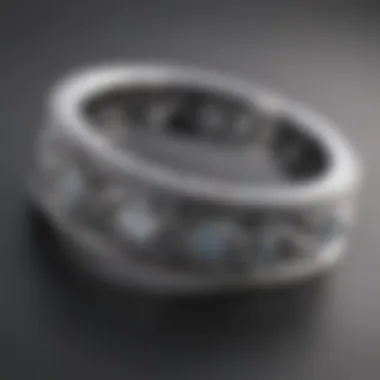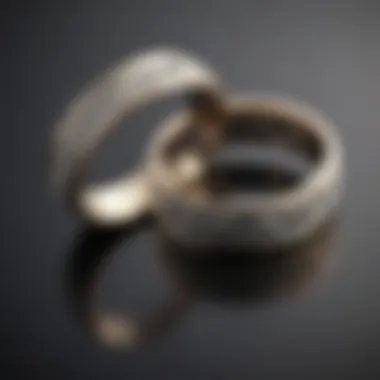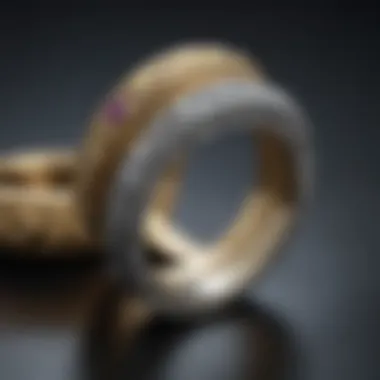Exploring the Significance of Platinum and Gold Wedding Bands


Intro
The selection of wedding bands represents a significant decision in a couple's journey. Among the myriad of options available, platinum and gold stand out as the most prominent materials due to their unique properties, rich histories, and aesthetic appeal. Understanding the distinct characteristics of each metal is essential for informed decision making. This section will explore the uses, advantages, and cultural implications of these valuable metals, providing readers with a foundational overview that sets the stage for a more in-depth examination.
Gemstone Overview
Definition and Characteristics
Platinum and gold can be seen as gemstones in their own right, valued not only for their physical properties but also for their intrinsic beauty. Platinum is a rare and durable metal, known for its lustrous white appearance. It is extremely resistant to tarnish and scratches, making it an excellent choice for wedding bands that are worn daily. Gold, on the other hand, comes in various colors and karats. The most common types include yellow gold, white gold, and rose gold. Gold's malleability allows for intricate designs that can appeal to various personal tastes.
Classification of Gemstones
The classification of gemstones typically relies on specific properties such as composition, hardness, and brilliance. Although platinum and gold are not classified as traditional gemstones like diamonds or emeralds, they do possess qualities that elevate them within the context of jewelry:
- Platinum:
- Gold:
- Rare and heavy
- Non-reactive, thus hypoallergenic
- Retains its value over time
- Available in different karats (e.g., 14K, 18K, 24K)
- Mixed with other metals for strength and color variation
- Highly regarded for its beauty and luster
Historical Significance
Ancient Uses and Cultural Importance
Historically, platinum and gold held significant roles across various cultures. Gold has been valued since ancient times, symbolizing wealth, power, and love. It played a central role in many civilizations, notably the Egyptians, who adorned their tombs with gold artifacts. Platinum, discovered later, became synonymous with luxury and privilege in European societies. Its rarity contributed to its status, as it was often favored by royalty and affluent individuals. The historical thread interweaves these metals with themes of commitment and status, reinforcing their importance in wedding traditions.
Myths and Legends Surrounding Gemstones
Throughout history, various myths have surrounded gold and platinum, often attributing mystical properties to these metals. Gold has been associated with gods and immortality in many myths. In contrast, platinum was thought by some cultures to possess magical qualities, symbolizing purity and eternal love. These narratives contribute to the emotional significance attached to wedding bands, intertwining them with shared cultural heritages that are as meaningful as the metals themselves.
"Choosing a wedding band is not just about a physical item; it is about tradition, emotion, and the personal journey of love between two individuals."
In summary, platinum and gold offer not only aesthetic appeal but also deep historical and cultural significance. As couples navigate their options, understanding these aspects can heighten the value of their choice, transcending mere materialism to reflect a bond of love and commitment.
Foreword to Wedding Bands
Wedding bands hold a central place in the traditions and rituals surrounding marriage. These rings not only symbolize the union between two individuals but also represent enduring commitment. Couples often choose their wedding bands with considerable thought, reflecting their personal tastes and values. In this section, we will explore the cultural significance and the evolution of wedding band designs, shedding light on why these pieces of jewelry carry such deep meaning.
Cultural Significance
The act of exchanging wedding bands has roots in various cultures around the world. Rings, primarily made of precious metals like platinum and gold, signify love, fidelity, and a binding promise between partners. In many cultures, the circular shape of the ring is viewed as a symbol of eternity, representing the endless love that couples vow to share.
Traditions surrounding wedding bands vary widely. In some societies, the ring is worn on the left hand, while others opt for the right hand. The particular customs often reflect historical and cultural values, emphasizing how marriage is regarded in different contexts. Understanding these traditions enhances the appreciation of why wedding bands carry such weight in romantic partnerships.


Evolution of Wedding Band Designs
The design of wedding bands has transformed significantly over the centuries. Early bands were typically simple in design, often crafted from plain metals and reflecting a more utilitarian purpose. However, as society evolved, so did the aesthetics surrounding wedding bands.
In the Victorian era, for instance, intricate designs and engravings became popular, with couples seeking features that showcased craftsmanship. The Art Deco period introduced geometric patterns and bold styles, further diversifying the market. Today, modern wedding bands offer a range of options from classic designs to contemporary aesthetics. Trends now include a blend of metals, unique textures, and personalized engravings, allowing couples to express their individuality through their wedding bands.
This evolution underscores the fact that wedding bands are not simply accessories; they are reflections of love, history, and personal expression.
Understanding Platinum Wedding Bands
Platinum wedding bands have earned their place as a symbol of commitment for many couples. Their unique characteristics differentiate them from other metals, making them a preferred choice for some. Understanding platinum involves not just recognizing its beauty, but also its intrinsic properties that appeal to discerning couples. It represents durability, timeless elegance, and a deep connection to commitment.
Physical Properties
Platinum is a dense and heavy metal, making it renowned for its strength and resilience. In fact, it is denser than gold, which gives it a substantial feel on the finger. This property also helps platinum withstand typical wear and tear remarkably well. It is resistant to scratches and tarnishing, which ensures a lasting brilliance.
The metal’s natural white sheen adds to its allure. Unlike white gold, which may require rhodium plating for its bright appearance, platinum maintains its silvery luster without needing heavy treatments. This makes it an attractive choice for engagement and wedding rings that are likely to be worn daily.
Alloy Composition
Platinum is often alloyed with other metals to enhance its durability for jewelry applications. Common alloying metals include iridium, ruthenium, and palladium. The mixture creates platinum alloys such as 950 Plat, which is 95% platinum and 5% of other metals. This ensures rings can withstand daily wear without significant degradation. Knowing the alloy composition is important when considering the longevity and care needed for the ring.
Rarity and Availability
The rarity of platinum is another factor in its desirability. Unlike gold, which is mined in large quantities, platinum is much scarcer. The extraction process is labor-intensive and costly. As a result, platinum wedding bands hold not just aesthetic but also market value. The limited availability impacts not only the price but also the appeal to couples looking for something unique. Potential buyers should be aware that this rarity can affect their choices.
Cost Considerations
Cost is often a significant determinant when deciding on wedding bands. Platinum can be more expensive than gold due to its rarity and the complicated mining process involved. On average, platinum wedding bands can be 30% to 50% more expensive than equivalent gold bands. Buyers should consider their budget and evaluate if the features of platinum justify the cost for their particular situation.
Attributes of Gold Wedding Bands
Gold wedding bands hold a prominent place in the jewelry world. Their significance lies not only in their aesthetic appeal but also in the diverse qualities they possess. Understanding these attributes helps couples make well-informed decisions when choosing the symbol of their commitment. Factors such as purity levels, color variations, historical context, and market trends all contribute to the allure of gold as a favored material for wedding bands.
Purity Levels in Gold
Gold purity is a critical factor to consider. The purity levels are measured in karats, with 24K representing pure gold. However, most wedding bands range from 14K to 18K due to their enhanced durability. Lower karats may be more suitable for everyday wear. Each karat level brings its own characteristics. For example, 18K gold contains approximately 75% gold, resulting in a richer color and greater value. The remaining portion often consists of alloy metals, which can affect the ring's strength and hue. Couples should weigh the trade-offs between value and durability when selecting a purity level for their wedding bands.
Color Variations of Gold
Gold wedding bands come in several color variations. Each color offers different aesthetic qualities and appeals to distinct tastes.
Yellow Gold
Yellow gold remains a timeless choice. It is the classic color of gold, radiating warmth and luster. It traditionally symbolizes wealth and luxury. The rich hue is attributed to the high gold content, which is often mixed with metals like copper or zinc. One of its benefits is its compatibility with various skin tones. However, it can scratch more easily than harder alloys. This softness may require more maintenance to preserve its shine.


White Gold
White gold offers a modern alternative to traditional yellow gold. It has a sleek and contemporary look, often compared to platinum. The key feature of white gold is its plating with rhodium, which enhances its brightness and resistance to tarnish. Due to its durability, white gold is less susceptible to scratches. However, the rhodium plating can wear off over time, necessitating re-plating every few years. This contributes to both maintenance considerations and long-term costs.
Rose Gold
Rose gold has gained popularity for its romantic appeal. Its distinctive pink hue is created by mixing gold with copper. The combination not only provides a unique color but also adds to the metal’s durability. Many couples appreciate rose gold's warm tones and its ability to pair well with other jewelry. However, those with sensitive skin may experience irritation from the copper content. This is an important consideration for anyone selecting a wedding band.
Gold's Historical Context
Gold holds deep historical significance as a symbol of wealth and status. Its use dates back thousands of years. Civilizations such as the Egyptians and Romans prized gold for its beauty and rarity. Gold adornments often found in tombs symbolize eternity and immortality, reflecting the culture's values. Understanding this history can enhance the emotional significance of a gold wedding band.
Market Trends in Gold Pricing
Finally, keeping current with market trends is crucial when considering a gold wedding band. Gold prices fluctuate due to various factors, including global economic conditions and mining efficiencies. The market's unpredictability can impact the overall cost of gold jewelry. Couples must be mindful of these fluctuations to make an informed decision that aligns with their budget and expectations. Monitoring these trends can help couples purchase during more favorable market conditions.
In brief, understanding the attributes of gold wedding bands empowers couples to choose the most suitable rings that reflect their personal style and values.
Comparative Analysis of Platinum and Gold
The comparative analysis of platinum and gold wedding bands is essential for couples choosing the perfect symbol of their commitment. Understanding the differences and similarities helps inform decisions based on durability, aesthetic, symbolism, and market considerations. Each material brings distinct properties that affect its long-term performance as a wedding band.
Durability and Maintenance
Platinum is renowned for its durability. This metal is denser and more resistant to wear than gold. Gold wedding bands, while beautiful, often require more frequent maintenance. They can scratch more easily, particularly in softer gold alloys. Couples might have to refinish their gold rings more often than platinum ones. Therefore, if longevity and low-maintenance are priorities, platinum might be a better fit.
Aesthetic Appeal and Craftsmanship
Finish Options
Finish options are critical in defining the visual character of wedding bands. Platinum bands typically offer a highly polished finish that gives them a distinct luster. This makes them appealing for luxury seekers. However, some individuals may prefer a matte or brushed finish, which can hide scratches and add texture. Gold also provides a variety of finishes, including polished, matte, and hammered textures. The choice of finish can significantly impact the overall look. It also aids in expressing personal style.
Engraving Possibilities
Engraving possibilities on wedding bands allow for personal touches that make the rings uniquely meaningful. Platinum is more challenging to engrave due to its hardness, but the engraving is sharp and deep, making it last longer. Gold, on the other hand, is easier to engrave, allowing for more elaborate designs. Couples may choose to engrave anniversaries or personal messages. This aspect adds to both metals' appeal, giving a sentimental edge.
Symbolism and Meaning
Both metals hold significance. Platinum is often seen as a symbol of strength, purity, and endurance. It represents a lasting bond, making it a fitting choice for wedding bands. Gold symbolizes wealth and prosperity. It connects to tradition and history, with ties to ancient civilizations. Understanding these meanings can help individuals choose a ring that resonates with their values and aspirations in their union.
Resale Value Considerations
Resale value is another important factor. Platinum typically holds its value well due to its rarity and demand. Gold's market fluctuates, influenced by various factors, including economy and mining output. When considering future resale options, understanding market trends is crucial. Couples should think about how much value they place on the resale aspect of their wedding bands.
It is wise to consider personal preferences, individual lifestyle, emotional connections, and practical needs when selecting between platinum and gold wedding bands.


Navigating these factors can lead to a thoughtful decision, aligning with both personal taste and long-term considerations.
Making an Informed Decision
When selecting a wedding band, understanding the significance of various options is crucial. The decision goes beyond simple aesthetics; it incorporates personal values, lifestyle preferences, and long-term implications. Thus, making an informed decision ensures that couples not only choose rings that resonate with their tastes but also align with their future plans.
Personal Preferences and Lifestyle
Couples often have differing styles and lifestyles. Personal preferences play an integral role in the selection of the wedding band material. For example, an active individual may prioritize durability, leading to a preference for platinum, known for its toughness. On the other hand, someone who treasures tradition may lean towards gold for its historical significance.
It is also vital to consider how the wedding band fits into daily life. Is it worn during work, exercise, or special occasions? Lifestyle should inform choices.
Consultation with Jewelers
Engaging with experienced jewelers can provide valuable insights. Jewelers can offer guidance on the nuances between platinum and gold, including how they wear over time, pricing fluctuations, and care requirements. They can also suggest reputable brands and local artisans who can craft unique, personalized designs.
As an advantage, speaking to jewelers allows couples to physically experience the materials. Feeling the weight of platinum versus the warmth of gold can often sway opinions.
Long-Term Care and Maintenance Tips
Each material requires different maintenance strategies. Knowing how to care for a wedding band prolongs its life and appearance.
- Platinum: Regular polishing may be needed to maintain its luster, but its density makes it resilient to scratches.
- Gold: Gold can tarnish and may require gentle cleaning to restore shine.
Understanding these differences can guide buyers in making choices that fit their lifestyle. A well-cared-for ring can maintain its beauty and symbolism of commitment for years to come.
Key Takeaway: The decision-making process involves assessing personal preferences, consulting experts, and understanding maintenance needs. Couples should take the necessary time to evaluate their options carefully.
By focusing on these elements, individuals can navigate their options more effectively, leading to a wedding band that resonates with both their identity and values.
Culmination
The conclusion of this article underscores the multifaceted significance of platinum and gold wedding bands. The choice between these two metals is not merely a matter of aesthetics, but also reflects personal significance and emotional bonds. Each option carries its own unique set of characteristics that resonate deeply with couples.
Summarizing Key Points
Throughout this article, we have examined essential aspects of both platinum and gold wedding bands. Key points include:
- Cultural and Historical Context: Understanding the historical importance can guide selections. Platinum is often viewed as a modern symbol, while gold carries ancient roots.
- Physical Properties: Platinum's enduring nature contrasts with the versatility of various gold alloys, each offering distinct visual appeal.
- Cost Considerations: Acknowledging the price differences is vital for making informed financial decisions.
- Durability and Care: Depending on lifestyle, couples must consider maintenance and the durability of each metal.
These points help guide couples in making thoughtful choices that align with their values and lifestyle.
Final Thoughts on Choosing a Wedding Band
Ultimately, selecting a wedding band is deeply personal. A ring is not just a piece of jewelry; it serves as a timeless reminder of commitment.
Consider how each material reflects your personal taste and emotional connection. Consultation with experienced jewelers can enhance the decision-making process.
In closing, whether it's the robust appeal of platinum or the warm hues of gold, both metals offer meaningful choices. Evaluating long-term implications such as maintenance and cultural significance can lead to a more satisfying and informed decision.
Both platinum and gold hold significant weight in the context of marriage. Choose what resonates most with your heart.







